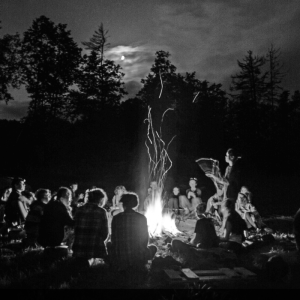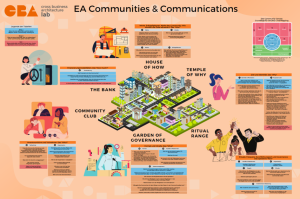Result
EA Communities & Communication
"EA campfire": How communities make architects stronger
The term communities these days refers to groups of people who have a common interest. These communities can be very big and diverse (e. g. cooking communities) or very focused – on the procurement of spare parts for certain vintage cars, for example. What’s relatively new here is the fact that these mostly self-organized / loosely organized groups are also able to learn collectively, develop things together, and change views and even attitudes. Not surprisingly, companies have now begun exploiting the power of communities. Among other things, the increasing implementation of agile work methods at companies is promoting the trend toward specialized communities in business organizations.
These communities tend to be less hierarchical and more collaborative than the organizations in which they exist, but they also present several challenges.
The "EA Communities & Communication" workstream therefore examined how EA communities can be established and managed at companies.
Several of the ten companies that par- ticipated in the workstream already had some experience with EA communities, and they contributed their knowledge to the workstream. Certain approaches are also now being used to expand the scope of EA communities beyond pure enterprise architecture to include relat- ed operations in IT and business units and departments.
"We ourselves actually worked a little like a community," says Workstream Coordinator Susanne Huber. "This became an option because all of our meetings were virtual. It led to a few challenges at first, but we quickly adjusted to the new conditions. For example, we started meeting much more frequently than we would have
if the meetings had been in person.
The meetings themselves were very efficient, but we were also able to loosen things up by incorporating social components."
We ourselves actually worked a little like a community. This became an option because all of our meetings were virtual.
The workstream determined that the following aspects are important when setting up and managing an EA community:
- Delineate a clear "sphere of activity".
- Select the target group of individuals who are to be approached.
- Analyze work results, feedback, and suggestions from the community.
- Find a balance between business (EA) and social interaction.
- Stay focused on the needs and expectations of community members.
- Be tactful when it comes to balancing autonomy and management.
- Identify suitable analog and digital formats for exchanging knowledge.
- Ensure marketing – i. e. regular communication and dissemination of work results beyond the community.
- Pay attention to the community lifecycle that extends from the establishment and development phase to the maturing and cell division phase.
- Companies need to promote and support the formation of communities if these are to function properly.
Good community practice among the workstream participants
Workstream participants conducted research using many sources that have analyzed specialized communities. At the same time, the participants were able to contribute the experience they have gained at their own companies. Here are some examples:
One of the participating companies operates a system known as Architecture Sync, which is a community of practice that conducts working sessions on a regular basis in which senior architects from the areas of digital solutions, digital services, and digital governance get together to exchange ideas and information.
The overriding goal of the community is to achieve "the participatory further development of the discipline of enterprise architecture and its methods" within the company. The community sees itself as a working group that jointly develops decisions and shares responsibility for their implementation and success. The same company has also established another open format known as the "Architecture and Data Community Event", which addresses not only employees who work on architecture or on something relating to architecture but also all other employees who are interested or involved in architecture and data issues.
EA Jour Fixe and BAT Face2Face
Another workstream member company has organized two community events: EA Jour Fixe and BAT Face2Face (BAT = business architecture team).
The EA Jour Fixe is something like an "EA campfire". Here, business architects who are members of the enterprise architecture teams meet onsite oder remotely once every quarter for two hours. Other individuals who are involved in architecture work are also invited to attend these meetings when their particular input and expertise is needed.
The meetings help align the activities conducted by the various business architecture teams and also make it possible to coordinate these activities with those carried out by the enterprise architecture team. The result is an inspiring exchange of ideas and better operational collaboration. Short presentations and descriptions are used to place current issues in the architectural context. Subsequent feedback and discussions then serve to promote further cooperation. In-person activities such as meeting for drinks, dinner, bowling, cooking courses, etc. are now being planned as COVID-19 restrictions are eased.

The BAT Face2Face meetings are also held every quarter. Two business architecture teams and the enterprise architecture team always participate in these meetings, whereby the enterprise architecture team acts as a coach and enabler. The goal is to establish an extensive exchange of ideas and information and direct operational collaboration between all parties. One of the two business architecture teams manages the meeting invitations and preparations, while the enterprise architecture team proposes the agenda for each meeting.
EA Community Round Table and EA Community Channel
Another workstream member company holds a monthly EA Community Round Table and also has an EA Community Channel in MS Teams.
The company’s EA department invites enterprise architects, solution architects and representatives of relevant internal EAM interest groups to the Round Table, which usually lasts about 90 minutes and is meant to promote the exchange of ideas and information within the EA community and relevant internal interest groups. The Round Table meetings are moderated by an enterprise architect and have a standard agenda.
The EA Community Channel is a closed channel in MS Teams. This channel can be accessed by the IT management committee, all IT architects, and representatives from EA-related fields such as IT security, DevOps, application management, infrastructure and cloud management, data management, etc.
The goal of the EA Community Channel is to gather and exchange information on new developments in enterprise architecture management (e. g. governance-related adjustments, EA tool adjustments, meetings and events, training courses, etc.) and share news about things like application approvals and their documentation.
Workstream summary
There is no single recipe for success when it comes to establishing an EA community and ensuring it will offer a company and its employees real benefits. The approach used to establish an EA community will depend on the con- text in which such a group will operate at a company. It also depends on the employees themselves and their willingness to effectively organize, manage, and protect small communities in their early stages of development. In those companies that already have experience with EA communities, the groups have now become an indispensable part of communication and collaboration on issues relating to enterprise architecture.
The workstream has published a white paper and infographic that offer interested companies specific instructions on how to establish and effectively operate and manage an EA community.
 Deutsch
Deutsch  English
English 
